Alcatel DECT 4074 GH, DECT 4074 GI, DECT 4074 GC, 4400, DECT 4074 GB Manual
...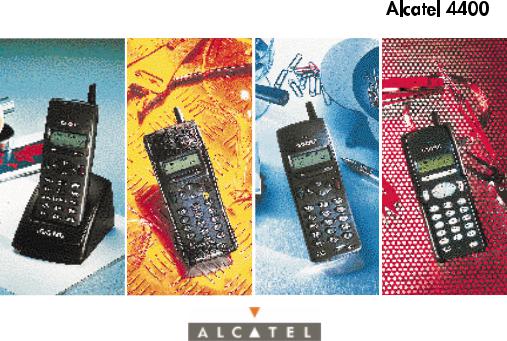

User guide
DECT 4074 GB/GB Ex, GH/GI, GC Alcatel 4400
You now have a DECT 4074 GB/GB Ex, GH/GI, GC terminal that will give you simple and easy access to all the services and functions provided by your Alcatel 4400 system.
This user guide gives you:
-a full description of your terminal,
-an alphabetic index of the services and functions available,
-progressive practice in the use of these services and functions, divided into five sections:
•General
•Your calls
•For your convenience
•While you are away
•Using your terminal in GAP mode (description of utilisation and partial operation with a DECT system other than your Alcatel 4400).
Whatever you need from a telephone system, your DECT terminal and your Alcatel 4400 system will provide it.
Note: Availability of some of the functions described in this guide may depend on your system release or configuration. If in doubt, consult your system manager.
Name: .............................................. |
Tel. No.: ..................................... |
Fax. No. : .......................................... |
GSM No.: ................................... |
E-mail address: .................................. |
DECT No.:................................... |
1

Symbols used in the documentation
The action "Press" is represented by
User-programmed or preprogrammed keys are indicated by
All preset or customised function codes are fully explained in the code table included with this documentation.
Keys can be programmed to customise your terminal and this is described on page 52. All programming functions are presented by group, on pages 53 to 56.
2
System information
Depending on your system configuration, your terminal can be single-line (no line keys) or multi-line (you have two line keys).
On a multi-line terminal, the enquiry call function can be configured in one of two modes:
-single-line (or PABX) mode,
-multi-line (or key system) mode.
This difference notably implies different activation of the enquiry call, broker call and transfer functions, depending on the selected mode.
Note: for further details concerning your system configuration, consult your system manager.
3
4
D E S C R I P T I O N O F T E R M I N A L
5

Display screen
Your telephone has a display screen, with two lines of 16 characters each.
The 1st line gives general information and the 2nd line shows the symbols for the keys programmed and the status of the set.
- |
Terminal idle (display screen also obtained by pressing |
): |
|
|
1st line: |
date and time or blank. |
|
|
2nd line: |
set locked, lock keypad, radio signal level, battery charge status |
|
- |
During a call: |
|
|
|
1st line: |
informations sur votre correspondant et sur la conversation en cours. |
|
|
2nd line: |
radio signal level and symbols indicating current call status. |
|
When the terminal is idle, it goes into standby after a few seconds, and the display screen then only shows the receive symbol and the battery symbol.
Line keys
In multi-line configuration, the set has two line keys which can be used to make or receive a call.
In single-line configuration, the left-hand key EnqOff  cancels an enquiry call and the
cancels an enquiry call and the
right-hand key |
Broker |
provides transition between the two calls. |
6
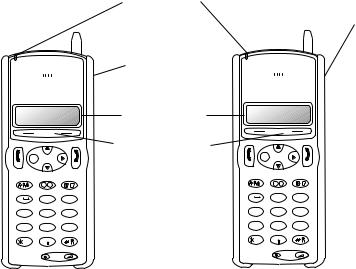
C
OK
ON |
|
OFF |
|
1 2 |
A |
|
B |
|
1 |
2ABC |
3 DEF |
4GHI |
5 JKL |
6 MN |
7PRS |
8 TUV |
9WXY |
MF |
0OQZ |
|
4074 |
|
|
DECT
Green LED |
Headset socket |
Headset socket
Display screen
Line key
C
OK
ON |
|
|
OFF |
|
1 2 |
A |
|
|
B |
||
1 |
2ABC |
3 DEF |
|
4GHI |
5 JKL |
6MNO |
|
7 RS |
8 |
|
9 YZ |
PQ |
|
TUV |
WX |
MF |
0 |
|
|
4074 |
|
|
|
Note: depending on the terminal version, letter assignment on keys may differ slightly (two possible layouts)
7

Fixed keys
The fixed keys facilitate access to predefined functions:
ON
OFF
A
B
:long press: switch ON. single press: off-hook.
:long press: switch OFF.
single press: on-hook, or quit programming mode.
:single press: transfer call to another extension. long press: redial last number sent.
:single press: access personal directory. long press: access "Call by name" function.
|
MF |
: long press: send DTMF codes (during call). |
0 |
|
: long press: access mobile customisation. |
OK
:during call: adjust audio volume. no call: lock or unlock keypad.
:long press: access local customisation menu.
:validate entry or initiate a call by name.
:scroll display screen pages.
C: move up one line in a list, or erase last character entered.
: move down one line in a list, or enter a space.
8
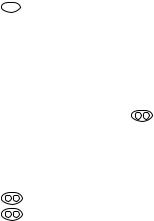
8 TUV
:models 4074 GI and GC: long press: to switch directly from ringer mode to buzzer mode (and vice-versa). The active mode is indicated:
•long beep: ringer active,
•short buzz: buzzer active.
Programmable keys
Two programmable keys 1 2 are provided. These make it possible to:
-call an internal or external number directly,
-activate a feature.
Default options:
1 |
2 |
(single press •): Key unassigned |
1 |
2 |
(long press ‚): Message |
Green LED
The green LED indicates:
-an incoming call: LED flashes at call ringing frequency. This facility is useful when the ringer has been deactivated,
-leaving radio coverage zone: LED flashes.
9

Headset socket (only on models GH and GI)
The headset socket enables a headset (microphone and earphones) to be connected. When the headset is connected, the terminal microphone and earphones are automatically deactivated.
Only headsets recommended by Alcatel should be used. If other headsets are used, Alcatel declines all responsibility for the consequences.
If a "Headset function" programmed key is available, calls can be received "handsfree".
Symbols corresponding to keys
Communication |
|
|
Incoming call. |
|
Communication in progress or call being made (when line keys have |
|
been defined). |
or |
Communication on hold. |
Service |
|
•‚ |
Service activated (steady) or service requiring action (flashing). |
10

Radio reception
Limit of coverage zone (flashing) or poor reception (steady)
Reception OK (steady)
Battery (no symbol if terminal on charge = fault)
Battery discharged or defective (flashing).
Battery charged (steady).
Battery on charge (flashing).
11
I N D E X |
|
A |
|
Absence |
|
leaving a message for internal callers ........................................................ |
69 |
reading messages left in your absence....................................................... |
69 |
Appointment (programming an appointment reminder)..................................... |
57 |
B |
|
Broker call (switching between calls) ............................................................. |
37 |
C |
|
Call by name ............................................................................................ |
33 |
Call, internal ............................................................................................. |
32 |
Call, outside.............................................................................................. |
32 |
Callback request ................................................................................... |
39, 70 |
Callback, automatic (requesting automatic callback by a busy internal terminal .) 38 |
|
Calling a "private" outside number .............................................................. |
61 |
Calling a second person during a conversation.............................................. |
34 |
Calling an associate (your secretary or colleague, etc.)................................... |
34 |
Camping on |
|
preventing a call from being placed on hold............................................... |
38 |
Code (programming your personal code) ...................................................... |
50 |
12
Conference |
|
three-party ............................................................................................. |
37 |
Cost (obtaining the cost of the last outside call) .............................................. |
61 |
Customer account (charging calls directly to customer accounts)........................ |
61 |
D |
|
Directory |
|
calling a number from the system directory ................................................. |
41 |
calling from your personal directory........................................................... |
40 |
programming your personal directory ........................................................ |
57 |
Do not disturb ........................................................................................... |
58 |
F |
|
Forwarding your calls |
|
cancelling forwarding .............................................................................. |
67 |
forwarding calls to a recorded message .................................................... |
66 |
forwarding calls to another number ........................................................... |
64 |
forwarding calls to your associate number.................................................. |
64 |
forwarding calls when you are busy.......................................................... |
59 |
forwarding your calls from another terminal ................................................ |
66 |
forwarding your calls to your pager .......................................................... |
68 |
forwarding your calls when your line is busy or you are away ..................... |
65 |
forwarding your calls while you are away ................................................. |
65 |
13
G |
|
GAP mode................................................................................................ |
71 |
General (utilisation of terminal 4074) ........................................................... |
17 |
Group |
|
hunt group ............................................................................................. |
42 |
temporary exit from your hunt group.......................................................... |
42 |
Groups, definition of function ....................................................................... |
53 |
H |
|
Hands-free (making or answering a call "hands-free") ................................... |
51 |
Hold (putting a call on hold)........................................................................ |
36 |
I |
|
Identity |
|
identifying the terminal you are on............................................................. |
58 |
picking up a call..................................................................................... |
40 |
Improving reception in a noisy environment.................................................... |
60 |
Intrusion into an internal conversation ............................................................ |
41 |
ISDN (making an lSDN call) ........................................................................ |
43 |
consulting the list of ISDN calls .................................................................. |
70 |
K |
|
Keys (programming a function on an unassigned key)..................................... |
52 |
14
L |
|
Language (selection)................................................................................... |
57 |
Locking your terminal ................................................................................. |
68 |
M |
|
Malicious calls (reporting)............................................................................ |
60 |
Message |
|
consulting recorded messages ................................................................... |
67 |
consulting the list of internal calls ............................................................... |
70 |
sending a written message to an internal correspondent ............................... |
43 |
O |
|
Operator |
|
calling the operator ................................................................................. |
33 |
P |
|
Pager |
|
making an internal call to a pager ............................................................ |
45 |
replying when your pager sounds ............................................................. |
68 |
Parking (parking a call) .............................................................................. |
38 |
Programmed key (calling using a) ................................................................ |
41 |
Programming |
|
customising your terminal.......................................................................... |
48 |
programming a function ........................................................................... |
52 |
programming your associate number ......................................................... |
58 |
programming your overflow terminal.......................................................... |
59 |
15
programming your personal code.............................................................. |
50 |
programming your personal directory ........................................................ |
57 |
programming your terminal....................................................................... |
49 |
R |
|
Receiver (adjusting sound volume during a call) ............................................. |
52 |
Receiving a beep....................................................................................... |
36 |
Receiving a call |
|
receiving a call ....................................................................................... |
35 |
receiving a second call during a conversation ............................................. |
35 |
Redial (redial the last number dialled) ........................................................... |
50 |
Reporting malicious calls ............................................................................. |
60 |
Ringer |
|
adjusting the ringer (tune and volume)........................................................ |
52 |
answering a night service bell................................................................... |
39 |
S |
|
Secret |
|
hiding your identity.................................................................................. |
60 |
Sending DTMF signals ................................................................................ |
42 |
Switching between calls (broker call) ............................................................ |
37 |
T |
|
Testing your terminal .................................................................................. |
59 |
Transfer.................................................................................................... |
36 |
16
4 0 7 4
T E R M I N A L S G E N E R A L
17
Principles of use
Zone of coverage
The DECT functions of your Alcatel system manage subscriber mobility, using DECT portable telephones.
Alcatel system radio coverage is provided by a number of base stations, transmitting within a radius of 20 m to 150 m (depending on the environment). The area covered by a base station is called a cell.
Routing
Outgoing calls can be made or incoming calls can be received, in any cell.
This telephone is not designed to be used inside a vehicle.
Radio transfer
Radio transfer enables a user to move between cells during a conversation. This function is automatic, with no loss of communication. In some cases, slight crackling may be audible in the telephone at the instant of transfer.
18
Conditions of use of telephone
You are about to use DECT type equipment, officially approved for private use between portable telephones and a private exchange (PABX), with no wire or domestic terminal connections.
In addition to the approval of the equipment, the following utilisation conditions must also be observed, notably due to the use of radioelectrical frequencies:
-the use of DECT equipment is not guaranteed against interference generated by other authorised users of radioelectrical frequencies,
-DECT equipment can only be used for links between fixed geographical points when the said points are not permanent installations, and the equivalent isotropic power radiated at the antenna shall not exceed 50 mW,
-DECT equipment (type PABX without wire link with more than two public lines) shall be installed by a technician approved by the ministry responsible for telecommunications, as such installations are considered to be complex installations,
-the conditions applicable to DECT equipment access to a telepoint network shall be defined in an contract with the authorised telepoint network operator concerned.
This terminal must only be used with an Alcatel system.
Do not expose the terminal to severe environments (rain, salty air, dust, etc.).
Terminal operation is not guaranteed outside an ambient air temperature range of - 20°C to + 55°C.
19
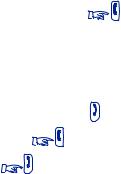
Use of terminal
Preparation for use
Delivered terminal specifications are:
-terminal 4074 (models 4074 GB/GB Ex or 4074 GH/GI or 4074 GC),
-battery (NiCd 600 mAh or NiMH 1200 mAh),
-battery box (depending on model).
Charge the terminal by installing it in its support (see p. 27).
Switching on the terminal |
|
To switch on the terminal, press key |
ON until an audible "beep" is heard and the |
display screen lights up. A short startup sequence is then run. If the terminal cannot be switched on or if the battery symbol is flashing, then either the battery needs charging or it is not fully inserted into the DECT set.
If the word "OUT" is shown on the display screen, then you are outside the area of coverage.
To switch off the terminal, press  OFF (long press).
OFF (long press).
To lift the handset, press |
ON |
To hang up, press |
OFF |
20
To facilitate use, keys with dual functions are used as follows:
-left-hand function on key: single press validated by a beep,
-right-hand function on key: long press (at least 1 second), validated by a second (lower note) beep.
Do not switch on the terminal close to gas or inflammable liquids.
Carrying the terminal
To avoid losing the terminal, adopt the habit of clipping it onto your belt.
The 4074 GH/GI terminal is equipped with a casing which protects it against impact.
Protecting your terminal with a case
Your telephone can be kept in a case, to protect it from impact, dust, liquids, etc. The use of a case is strongly recommended in severe environments.
Various models of case are available for the 4074 range.
For specific information concerning the various types of case, consult your installation technician.
CAUTION: The belt clip must be removed from the telephone to enable it to be easily inserted and removed from the case.
To remove the belt clip, on telephone models 4074 GB/GB Ex and GC, unscrew the mounting screw and carefully keep the belt clip for future use. On the 4074 GH/GI, first unlock the belt clip using the tip of a ball-point pen, pushing the top tab backwards, behind the clip. Then release the clip by sliding it down the telephone.
21

Locking the keypad of the terminal
To prevent accidental pressing of the keys, when the terminal is in standby the keypad can be locked.

 ,
,  1 followed by
1 followed by  2ABC ; symbol
2ABC ; symbol  lights up, indicating that the keypad is locked.
lights up, indicating that the keypad is locked.
The keypad is automatically unlocked if an incoming call is received (and will be locked again at the end of the call).
To unlock the keypad, the same procedure is used, and symbol  disappears.
disappears.
Backlighting of display screen and keys (terminal Alcatel 4074 GH/GI only)
A backlighting feature is provided for the display screen and the keys, allowing the terminal to be used in the dark.
The backlighting is activated by a long press (2 beeps) on 
The backlighting goes out when no key has been pressed for around 15 seconds. When another key is pressed, lighting is reactivated.
The same procedure is used to deactivate the backlighting.
This function can be activated or deactivated while a call is in progress. In this case, the pressing of the key is not validated by a beep.
Note: Excessive use of this function will discharge the battery prematurely.
22
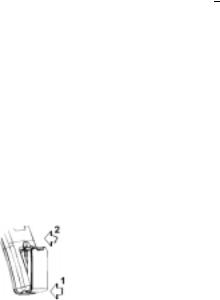
Beep other than during conversation
These beeps are specific to DECT sets:
-2 beeps indicate that the user is leaving the area of coverage. Conversation can only be continued if the user remains inside, or re-enters, the area,
-4 beeps indicate that the portable terminal battery needs charging. Symbol  also flashes on the screen.
also flashes on the screen.
Cleaning the terminal
The terminal does not require any specific servicing. However, it can be cleaned using a damp soft lint-free cloth.
Do not use soap or detergent, which could affect the colouring or surface finish of the terminal.
Installing the battery pack in the terminal
When installing the battery pack, do not use excessive force as no particular force is necessary. Engage the lower part first, then push the upper part gently until it clicks into position.
23
Charging unit
The charging unit must be close to an easily accessible mains power socket.
Characteristics
The terminal is supplied with a battery unit (depending on the model, 1200 mAh NiMH or 600 mAh NiCd).
This unit contains polluting substances and should only be discarded at a specific disposal point.
Battery life:
-using the NiCd battery:
•in standby, inside the area of coverage: 30 hours,
•in continuous conversation: 6 hours,
-using the NiMH battery:
•in standby, inside the area of coverage: 55 hours,
•in continuous conversation: 10 hours.
Note:
-A new battery must be charged for at least 12 hours, with the terminal off, to become fully operational.
-Batteries only achieve full capacity after around 10 charge/discharge cycles.
-So that the battery does not lose capacity, we recommend completely discharging it at least once every two months.
Simply use your terminal without placing it in its charging unit until the low charge indication appears. You can then completely charge it.
24

-Do not use non-rechargeable batteries. Attempts to charge will be unsuccessful and can seriously damage the terminal and/or charger.
Charging unit 4071DA
Charging unit 4071DA can be used as a stand for the terminal while the battery is being charged. The terminal can be ON or OFF.
3 |
5 |
|
1 |
||
|
4 
 2
2
The charging unit comprises:
-1 position for the terminal (1),
-1 LED indicating battery charge status (2),
-1 position for a spare battery (3),
-1 LED indicating the charge status of the spare battery (4),
-1 mains power connection cable (5).
Note:
-There can be two minutes difference between the fully charged indications given on the terminal screen and on the charger. This in no way affects the battery charge level.
25
